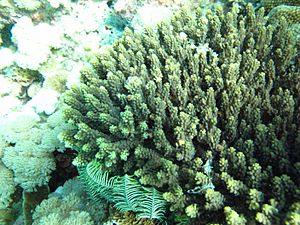Acropora cerealis facts for kids
Quick facts for kids Acropora cerealis |
|
|---|---|
 |
|
| Conservation status | |
| Scientific classification | |
| Synonyms | |
|
List
|
Acropora cerealis is a type of coral that lives in the ocean. It belongs to a family of corals called acroporids. You can find it in the Indian Ocean and the Pacific Ocean. This includes areas from the Red Sea to the Hawaiian Islands.
It lives in warm, shallow waters, usually 3 to 20 meters deep. This coral is sometimes collected for home aquariums. However, a type of Crown-of-thorns starfish likes to eat Acropora corals.
What It Looks Like
Acropora cerealis corals grow in interesting shapes. They can look like a bush or a flat-topped cluster. Their branches often interlock, connecting to other branches.
The branches are thin but have many small cups called corallites. These corallites make the branches wider. Some corallites are tube-shaped and built right into the branches. Others, called axial corallites, are also tube-shaped.
The tips of the branches can be blue, cream, pink, or purple. The main color of the coral can be cream, pale brown, or white. This coral looks similar to Acropora kimbeensis and Acropora plantaginea.
Where It Lives and Why It Needs Help
This coral is found in many places across the Indian Ocean and Pacific Ocean. This includes the Gulf of Aden, the Red Sea, Australia, and the Hawaiian Islands.
Scientists have listed Acropora cerealis as a "least concern" species on the IUCN Red List. This means it's not in immediate danger of disappearing. However, its population is thought to be shrinking. This is because coral reefs around the world are facing many threats.
- Rising Ocean Temperatures: Warmer water can cause coral bleaching. This is when corals lose their color and can die.
- Climate Change: Changes in the climate affect ocean conditions.
- Human Activities: Pollution and coastal development can harm reefs.
- Crown-of-Thorns Starfish: These starfish eat corals, including Acropora species.
- Diseases: Corals can get sick, just like other living things.
Because of these threats, Acropora cerealis is also listed under Appendix II of CITES. This means that trading this coral across borders is controlled to help protect it.
How It Was Discovered
This coral species was first described by a scientist named Dana in 1846.


